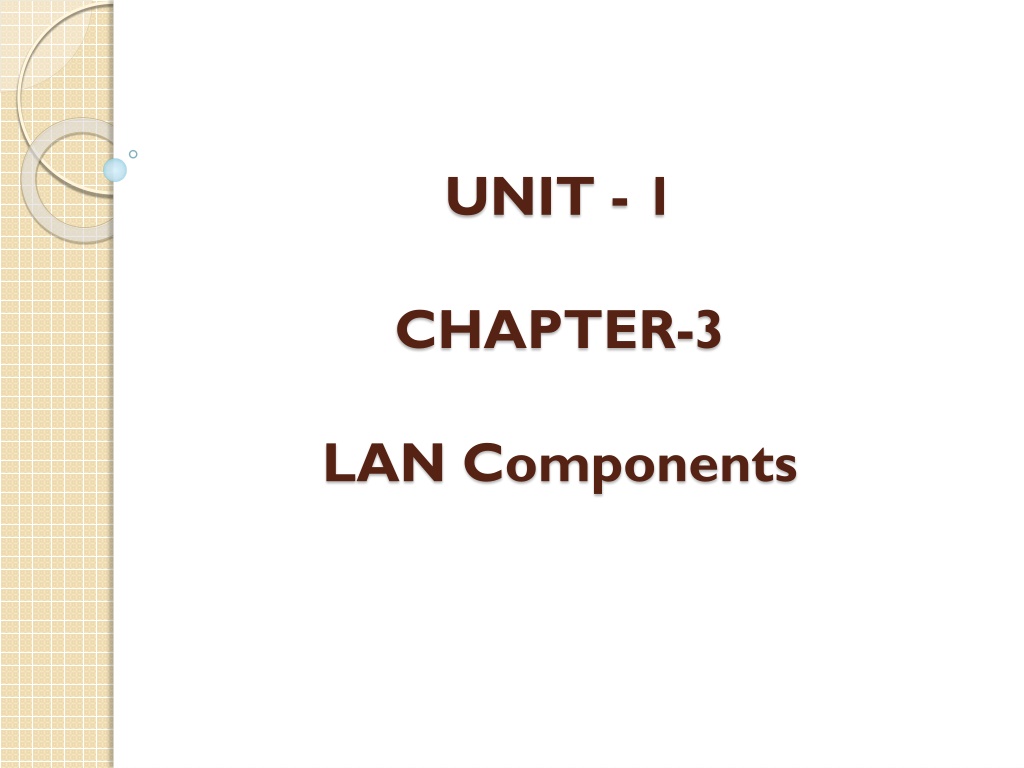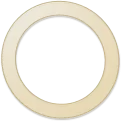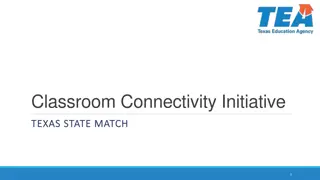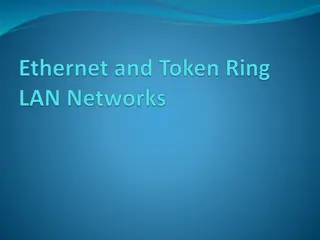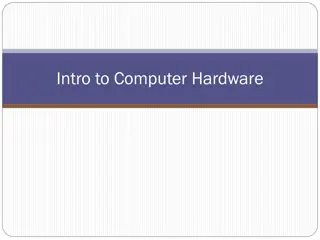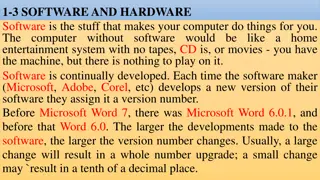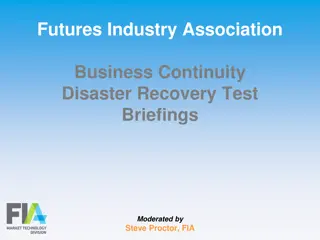LAN Hardware Components and Connectivity Mediums
LAN hardware components, such as cables, repeaters, hubs, switches, and network interface cards, play a crucial role in transmitting electric signals between devices. Cables are the primary connectivity medium, with factors like bandwidth and distance affecting data transmission. External disturbances like EMI and RFI can cause signal deterioration, leading to attenuation and distortion. Methods to overcome attenuation in LANs include using short cable lengths and amplifiers like repeaters and active hubs.
Download Presentation

Please find below an Image/Link to download the presentation.
The content on the website is provided AS IS for your information and personal use only. It may not be sold, licensed, or shared on other websites without obtaining consent from the author.If you encounter any issues during the download, it is possible that the publisher has removed the file from their server.
You are allowed to download the files provided on this website for personal or commercial use, subject to the condition that they are used lawfully. All files are the property of their respective owners.
The content on the website is provided AS IS for your information and personal use only. It may not be sold, licensed, or shared on other websites without obtaining consent from the author.
E N D
Presentation Transcript
UNIT - 1 CHAPTER-3 LAN Components
The hardware components of a LAN are devices operating at the physical layer or the data link layer and are responsible for transmission of electric signals from one device to another. To transmit electric signals, the following devices are commonly used in LANs: Cables Repeaters Hubs Switches Network Interface Cards. 1. 2. 3. 4. 5.
Cables: The most commonly used connectivity medium to connect computers or devices is a cable, a wire capable of transmitting signals from one device to another. When transmitting electric or optical signals from one device to another the following factors must be considered: 1. Bandwidth 2. Distance
Bandwidth Bandwidth is defined as the amount of data that can be transmitted by a cable for a fixed period of time. Bandwidth is usually measured in terms of bits of data transferred per second (bps) For example, a bandwidth of 10 Mbps indicates that the cable can transfer 10 megabits of data per second.
Distance When the distance between the devices is greater, the bandwidth decreases because the signal needs to travel over a greater distance. A part of the signal strength is utilized to overcome the resistance offered by the cable. An increase in the distance increases the chance of external disturbances such as Electromagnetic Interference (EMI), Radio Frequency Interference (RFI), or physical stress.
These external disturbances cause the signal to deteriorate, and, therefore, the amount of data, transferred decreases. The gradual deterioration of signal strength across long distances is called attenuation. The degradation of a signal due to internal or external disturbances is called distortion.
Attenuation is overcome in LANs by the following methods: 1. Short cable lengths:The amount of resistance offered by the cable is less, and, therefore, attenuation is reduced. 2. Amplifiers: Devices such as repeaters, active hubs, and switches are used to amplify the attenuated signal so that the destination computer or device can receive the signal.
Distortion When a signal is modified, the data transmitted by the signal becomes corrupt. As a result, the destination computer or device may not be able to interpret the signal and obtain the correct data. The following methods are commonly used to prevent distortion: 1. The possible causes and the effect of EMI or RFI in the network are analyzed, and use communication media that are resistant to interference. 2. Cables are not passed through regions of high interference. 3. Network protocols capable of detecting signal corruption are used to check errors data transmission.
The common cable types used to connect computers and devices in a LAN are: 1. Coaxial cables 2. Twisted-pair cables 3. Optical fiber cables
Coaxial Cables: A coaxial cable consists of two concentric conductors separated by insulation. The inner conductor transmits electric signals, and the outer conductor acts as a ground. The entire assembly is wrapped in a sheath of Teflon or PVC. Because the signal is transmitted over the surface of the inner copper wire, increasing the cross- section of the inner copper wire increases the amount of signal that can be transmitted by the cable. Therefore, a thicker coaxial cable can transmit more data than a thinner one.
The commonly used coaxial cables in Ethernet LANs are: 1. 10base2: Also known as thinnet, supports a data-transfer rate of 10 Mbps and can transmit signals without attenuation over a distance of 185 meters. 2. 10base5: Known as thicknet, supports a data- transfer rate of 10 Mbps over a distance of 500 meters.
Advantage: The advantage of coaxial cables is that they support high bandwidths and can transmit signals up to 10 kilometers. Disadvantage: The main disadvantage of coaxial cables is that they support only the bus topology. Coaxial cables do not support star topology.
Twisted-Pair Cables: Twisted pair cable consists of four pairs of thin copper wires coated with PVC or Teflon, spiraled around one another. Spiral results radiation between the copper wires and cancels the effect of EMI. The twisted-pair cables generally used in LANs are following types: 1. Shielded Twisted Pair (STP) 2. Unshielded Twisted Pair (UTP)
Shielded Twisted Pair (STP): In STP, an extra layer of metal foil is present between the twisted pairs of copper wires and the outer sheath. The purpose of this layer is to provide additional protection from EMI and RFI. However, this shielding reflects back the normal radiation emitted by the wires. This radiation may interfere with the signal transmitted by the cable, and as a result, corrupt the signal. To prevent this reflection, a coating of dielectric insulator, which absorbs the radiation, is provided on the internal surface of the metal foil.
Advantages: Generally used in networks where cables pass close to devices that cause high EMI/RFI. Disadvantages: STP is more expensive than UTP. In addition, the presence of shielding increases the resistance to the signal and, therefore, restricts the cable length and the throughput offered by STP.
Unshielded Twisted Pair (UTP): UTP cables are the most commonly used communication medium in LANs. Of the four pair in a UTP cable, however, only two pairs are actually used for communication in LAN provide speeds of up to 100 Mbps. All the four pairs are used only for higher transmission rates such as 1,000 Mbps.
Depending on the bandwidth offered, the following categories of UTP cables are defined: 1. Category 1 (Cat-1): Cat-1 supports analog voice data and is commonly used for telephone communication. Cat- 1 is also used in Integrated Services Digital Network (ISDN), a type of WAN connectivity option. 2. Category, 2 (Cat-2): Cat-2 cables are commonly used in IBM Token Ring networks. Cat-2 supports digital voice communication up to a speed of 4 Mbps. 3. Category 3 (Cat-3):The maximum data transfer rate supported by the Cat-3 is 16 Mbps. 4. Category 4 (Cat-4): Cat-4 supports a. maximum data transfer rate of 20 Mbps. 5. Category-5 (Cat-5): Cat 5 supports data transfer rates up to 100 Mbps and is used with Fast Ethernet.
Advantages: UTP cables are inexpensive and are resistant to physical stress. They also offer the flexibility to select a particular category of cable depending on the network requirements. Disadvantages: UTP cables should not be used if the network is located in an environment with higher EMI/RFI.
Optical Fiber Cables: Optical fiber cables transmit data in the form of light. Optical fiber cables contain long thin strands of pure glass, called the fiber, with each strand having a diameter of about 5 microns.
A typical optical fiber cable consists of the following three components: 1. Core: The core contains the optical fiber conductor (glass) that transmits light. 2. Cladding: The core is surrounded by another optical material to prevent any light from escaping the core. The function of cladding is to reflect the light back into the core. 3. Sheath or outer jacket:The core and cladding are covered with a sheath, usually made of plastic, to protect the fiber from damage.
Pptical fiber cables transmit data in the form of light. Therefore, the data to be transmitted is converted into light by a codec (coder and decoder) present at each end of the fiber. The codec converts the data from, the computer into light, and the light is then transmitted across the cable with the help of either a Light Emitting Diode (LED) or an Injection Laser Diode (ILD). At the destination computer, a decoder receives the light beam and converts it into data.
Multi-Mode Transmission: A mode is defined as the angle at which a ray of light enters the core of the optical fiber cable. If the light enters the core at different angles, it is called multi-mode transmission. Multi-mode transmission occurs when an LED is used as the light source. An LED is not a concentrated light source, and, therefore, the rays of the light beam disperse after traveling a certain distance through the fiber. The rays in the center of the beam do not disperse whereas the rays on the circumference of the light beam disperse and hit the cladding.
The dispersed light rays hit the cladding of the cable and are reflected back into the core. The dispersion and reflection occurs at different angles, or modes, resulting in multi-mode transmission. This dispersion and reflection of light rays does not affect their strength. Therefore, for a given signal, the dispersed light beams arrive later than the un-dispersed ones, a delay which can result in slower transmission rates.
Advantages: 1. Multi-mode transmission is inexpensive because the cost of LED is less than that of an ILD. 2. Multi-mode transmission is preferred in LANs and in networks that connect computers in a large college or school campus, which may be spread across a few miles. Disadvantages: 1. The drawbacks of multi dimensional Transmission- such as delay and attenuation occur only when the distance between the devices is more than a few miles. 2. Multi-mode transmission is not suited for WANs. 3. Another disadvantage of multi-mode transmission is the collision of light beams due to dispersion and reflection. These collisions weaken the signal strength, resulting in attenuation.
Single-Mode Transmission: In single-mode transmission, an ILD is used to emit a light beam (laser) that carries data. ILD is an extremely concentrated light source, and, therefore, the laser beams do not disperse when traveling through the fiber. As a result, all the light beams reach the destination at the same time. In addition, the beams do not collide, thereby preventing any attenuation of the light signals. Therefore, single-mode transmission is used to connect computers that are part of a LAN backbone or in large WANs spanning across a country.
Advantages: Because optical fiber cables transmit data in the form of light, they are resistant to EMI and RFI. Optical fiber cables are also used to connect computers that are far apart. Disadvantages: Optical fiber cables are expensive compared to coaxial and twisted-pair cables.
